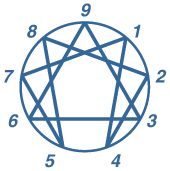by Emma Hickey
The Myers-Briggs Type Indicator, also known as the MBTI, is far and away the most popular personality quiz among people in the business world. It’s not unheard of for managers to ask new hires to take it, or for CEOs and executives to use their MBTI personality type as a means of explaining their working styles. Meanwhile, Millennials and Gen Zers have embraced astrology like no generation before, moving it from a fringe interest to something downright mainstream. As we discussed in a previous blog, personality quizzes in some form or another have long been attractive to the humankind. We may have evolved beyond trusting humorism or phrenology to understand each other’s personality types, but our love of being told who we are in clearly definable terms based off of a simple quiz will never go away. That’s where the Enneagram comes in. While it is indeed another simple personality test, its strategy for categorizing its test takers can lead to illuminating revelations you won’t get from the MBTI, or even astrology. It’s time the Enneagram gets its moment in the sun.
The Enneagram, or the Enneagram of Personality, is a system of understanding the human psyche by dividing it into 9 personality types. It’s a bit more cerebral than the black and white MBTI and uses the lens of trauma as a means of understanding the psyche as a whole. The 9 Enneagram personality types are each based upon how one reacts to traumatic or difficult situations, and the rest of the personality insights spiral out from that starting point.
The types are as follows, with descriptions provided by The Enneagram Institute:
The Reformer: The Rational, Idealistic Type: Principled, Purposeful, Self-Controlled, and Perfectionistic
The Helper: The Caring, Interpersonal Type: Demonstrative, Generous, People-Pleasing, and Possessive
The Achiever: The Success-Oriented, Pragmatic Type: Adaptive, Excelling, Driven, and Image-Conscious
The Individualist: The Sensitive, Withdrawn Type: Expressive, Dramatic, Self-Absorbed, and Temperamental
The Investigator: The Intense, Cerebral Type: Perceptive, Innovative, Secretive, and Isolated
The Loyalist: The Committed, Security-Oriented Type: Engaging, Responsible, Anxious, and Suspicious
The Enthusiast: The Busy, Fun-Loving Type: Spontaneous, Versatile, Distractible, and Scattered
The Challenger: The Powerful, Dominating Type: Self-Confident, Decisive, Willful, and Confrontational
The Peacemaker: The Easygoing, Self-Effacing Type: Receptive, Reassuring, Agreeable, and Complacent
The Enneagram is also represented by the following diagram:
The Enneagram diagram is useful because it shows how each personality type is connected. It’s no coincidence that 1 and 4 are connected by a line, or 3 and 6. These personality types are all interconnected. Each number represents your base personality type, while one of the two personality types connected to your base type is your “wing.” So if you’re a personality type 4, then either 1 or 2 will be your “wings.” In the world of Enneagram, it’s phrased as having a 1-wing or a 2-wing. The placement of each number around the diagram is also significant, because the circle is divided into three sections, or centers as they’re called in the Enneagram tradition. The centers are as follows:
These centers are defined by one main question: How does this person respond to ‘the loss of contact with the core of the self?” This is the way in which reactions to trauma influence the Enneagram. The personality types within The Instinctive Center respond with anger or rage, the personality types within The Feeling Center respond with shame, and the personality types within The Thinking Center respond with fear. If you’re a more visual person, there’s a diagram of this as well:
As you can see, the Enneagram contains many dimensions, each of which aims to drill down on what, specifically, defines aspects of your personality. This allows you to understand your personality as a sum of its parts, and attain better clarity into your own psyche.
The Enneagram is really useful in understanding your fixed personality. We all change over time, but the Enneagram gives you insight into your core, into the parts of you that are fundamental and do not change. This is one of the greatest differences between the MBTI and the Enneagram. Your MBTI personality can change over time, while your basic Enneagram personality type will not. These two personality tests can certainly complement each other, but there’s no reason the MBTI should have such a large presence in the zeitgeist while the Enneagram doesn’t. After all, it also reveals helpful insights into oneself.
There are many free Enneagram websites online, but two of our favorites can be found here, for a quick test, and here, for a longer, more robust examination. Give it a try! Put your faith in the Enneagram. Try treating it as Millennials treats astrology, or as most people in the business world treat the MBTI—take it yourself, send it to your friends, discuss your results with your colleagues. It will only aid in helping you, and the people who populate your life, work together better and understand each other better.



